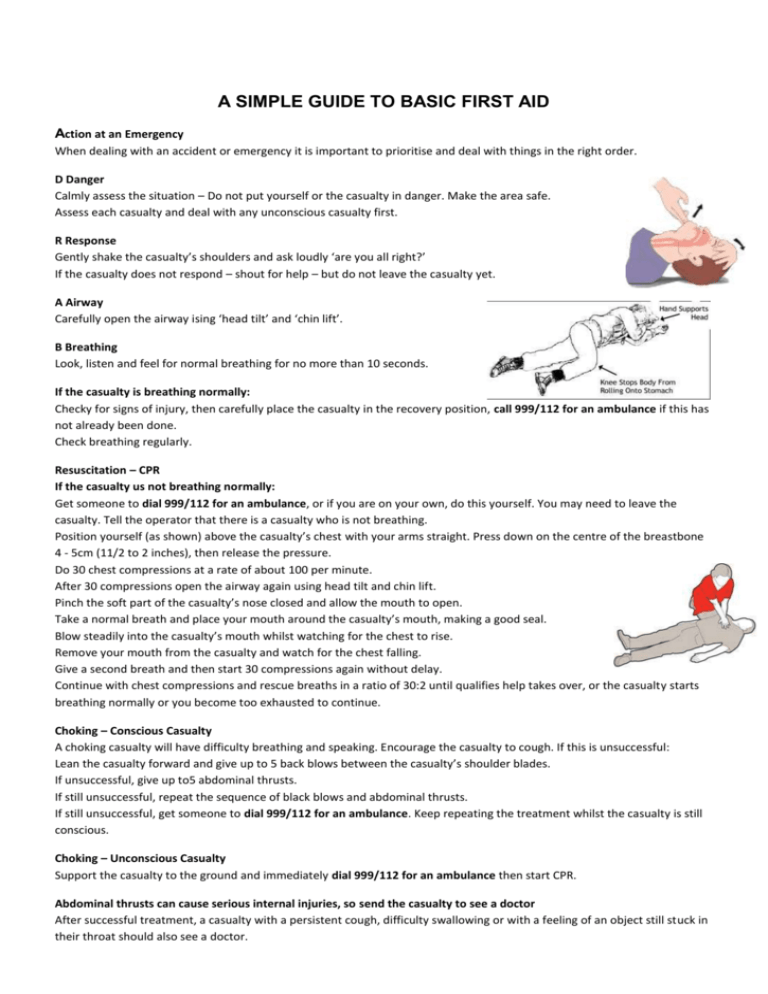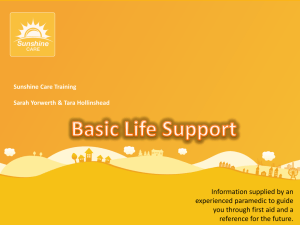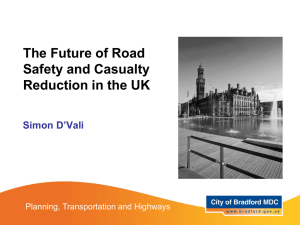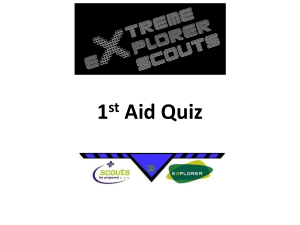Dave`s Free and Simple Guide to First Aid
advertisement

A SIMPLE GUIDE TO BASIC FIRST AID Action at an Emergency When dealing with an accident or emergency it is important to prioritise and deal with things in the right order. D Danger Calmly assess the situation – Do not put yourself or the casualty in danger. Make the area safe. Assess each casualty and deal with any unconscious casualty first. R Response Gently shake the casualty’s shoulders and ask loudly ‘are you all right?’ If the casualty does not respond – shout for help – but do not leave the casualty yet. A Airway Carefully open the airway ising ‘head tilt’ and ‘chin lift’. B Breathing Look, listen and feel for normal breathing for no more than 10 seconds. If the casualty is breathing normally: Checky for signs of injury, then carefully place the casualty in the recovery position, call 999/112 for an ambulance if this has not already been done. Check breathing regularly. Resuscitation – CPR If the casualty us not breathing normally: Get someone to dial 999/112 for an ambulance, or if you are on your own, do this yourself. You may need to leave the casualty. Tell the operator that there is a casualty who is not breathing. Position yourself (as shown) above the casualty’s chest with your arms straight. Press down on the centre of the breastbone 4 - 5cm (11/2 to 2 inches), then release the pressure. Do 30 chest compressions at a rate of about 100 per minute. After 30 compressions open the airway again using head tilt and chin lift. Pinch the soft part of the casualty’s nose closed and allow the mouth to open. Take a normal breath and place your mouth around the casualty’s mouth, making a good seal. Blow steadily into the casualty’s mouth whilst watching for the chest to rise. Remove your mouth from the casualty and watch for the chest falling. Give a second breath and then start 30 compressions again without delay. Continue with chest compressions and rescue breaths in a ratio of 30:2 until qualifies help takes over, or the casualty starts breathing normally or you become too exhausted to continue. Choking – Conscious Casualty A choking casualty will have difficulty breathing and speaking. Encourage the casualty to cough. If this is unsuccessful: Lean the casualty forward and give up to 5 back blows between the casualty’s shoulder blades. If unsuccessful, give up to5 abdominal thrusts. If still unsuccessful, repeat the sequence of black blows and abdominal thrusts. If still unsuccessful, get someone to dial 999/112 for an ambulance. Keep repeating the treatment whilst the casualty is still conscious. Choking – Unconscious Casualty Support the casualty to the ground and immediately dial 999/112 for an ambulance then start CPR. Abdominal thrusts can cause serious internal injuries, so send the casualty to see a doctor After successful treatment, a casualty with a persistent cough, difficulty swallowing or with a feeling of an object still stuck in their throat should also see a doctor. Bleeding Sit or lay the casualty down. Elevate the injured part, if possible. Apply pressure to the wound or around the wound if there is something embedded in it. Maintain pressure with a firm dressing. If blood come through the dressing, apply another on top of the first. If blood comes through the second dressing, remove both dressings and apply a new one, making sure that pressure is applied accurately to the point of bleeding. Severe bleeding can cause shock. Shock Some signs of shock are: pale cold clammy face and skin; Rapid weak pulse; feeling sick and dizzy; anxiety. The level of response may deteriorate and they may even become unconscious. Treatment: Lay the casualty down raising their legs, other injuries permitting; treat the cause e.g. bleeding etc; Cover the casualty with a blanket; Reassure; Dial 999/112 for an ambulance. Do not give the casualty anything to eat or drink. Do not let them smoke. Burns and Scalds Cool the burn as quickly as possible under cold, running water for at least 10 minutes. Remove any constricting items such as watches, rings etc, because the burned area may start to swell. Clothing that has not stuck to the wound may be removed carefully. Cover the burn with a sterile non adherent dressing or cling film, and seek medical advice. Dial 999/112 for an ambulance in severe cases. Injuries to Bones If a broken bone is suspected keep the casualty still and warm. Dial 999/112 for an ambulance if: There is a suspected fracture to the spine, head, neck or leg. The casualty has difficulty breathing. There is deformity, irregularity or unnatural movement. The bone has come through the skin. The casualty appears to be in a lot of pain. You can’t easily get the casualty to hospital whilst keeping the injury still. Eye Injury If there is something in the eye, wash out the eye with clear water or sterile fluid from a sealed container to remove loose material. Ensure the water runs away from the good eye. Do not attempt to remove anything that is embedded in the eye. Cover the eye and arrange transport to hospital dial 999/112 for an ambulance if in any doubt. If chemicals are involved, flush the eye with water or sterile fluid for at least 10 minutes, ensuring that the water runs away from the good eye. Ask the casualty to hold a sterile dressing over the injured eye. Dial 999/112 for an ambulance. Eyewash is available in 20ml & 500ml bottles. Accident Book All accidents to employees and visitors to your premises should be recorded in the accident book, no matter how minor. This way you can identify accident trends, identify minor accidents that could have been more serious and take steps to prevent similar occurrences. Dave’s useful tips for First Aid Stay Calm. Make sure your surroundings are safe without putting you or the casualty at risk, Assess the casualty and decide if they need medical attention. If in any doubt call for help. Reassure the casualty. Remember an unconscious casualty may be able to hear you. Talk to them and reassure. To prevent the infection of wounds always clean your hands thoroughly and wear disposable gloves. When you dial 999/112 to tell the operator you need an ambulance, you will be transferred to an ambulance service control centre. The operator will ask you a series of questions. These questions are important and will not delay the arrival of the ambulance. Don’t forget to replenish any items you use from you first aid kit. This leaflet contains only basic advice on first aid and is intended to be used in conjunction with a recognised first aid course. It is not substitute for effective training. Whilst every effort has been made to ensure the accuracy of the information contained in this leaflet, Source Solutions UK / Dave Osborne does not accept liability for any inaccuracies or for any subsequent mistreatment of any person, howsoever caused.




